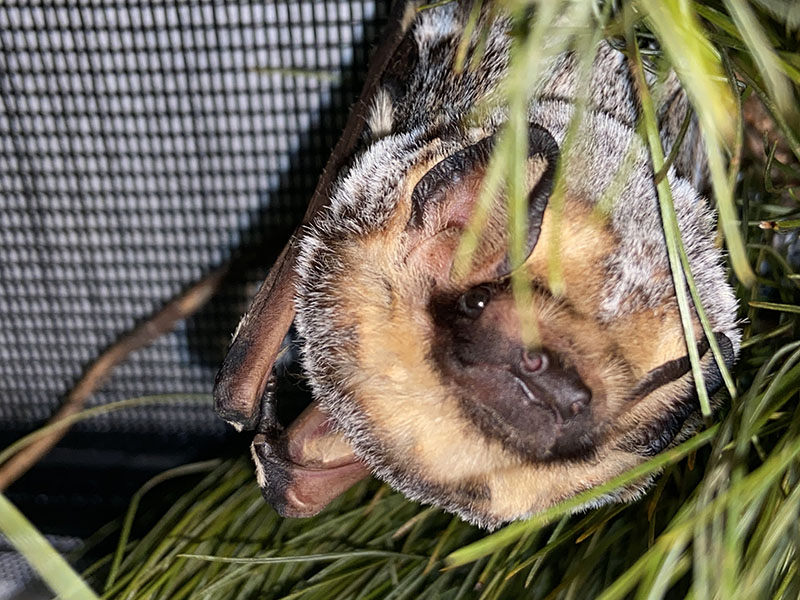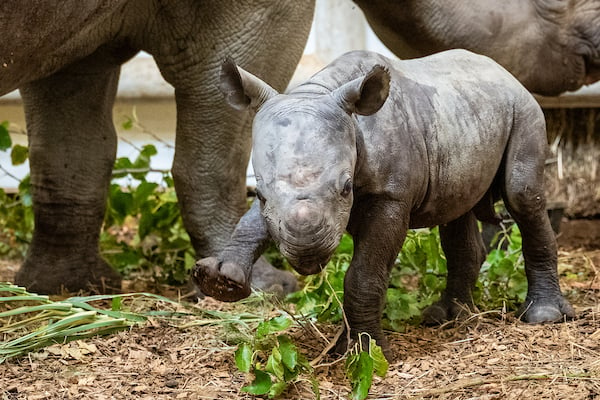(KUTZTOWN, Pa.) — If you were driving by the house with beige siding and maroon shutters on a winding road in Mertztown, Pennsylvania, you probably wouldn’t even notice it. The two-story dwelling sits back from the road, wrapped in a cozy blanket of trees. Unassuming in build, it is similar to other houses in the neighborhood. But there is something vastly different about this house, something that isn’t visible on the outside. If the home’s owner, Stephanie Stronsick, gave you a tour, you would notice that the two-car garage holds not cars, but bats.
The 150 bats in the garage, of various species, are recovering from different types of injuries or less-than-ideal circumstances, such as choosing to roost in a spot where they will come in contact with humans, like attics or mailboxes. When the weather fluctuates, bats get confused. Some are found roosting in trees with no cover. A bat found or placed outside during winter months will not survive. While several licensed wildlife rehabilitators in Pennsylvania treat bats and other rabies vector species (RVS), PA Bat Rescue specializes in and rehabs only bats. President Steph Stronsick, 39, founded the nonprofit in 2006 with the mission to educate, conserve, and rehabilitate bats. In 2022 she admitted 327 bats, and the number increases each year.
While many people don’t consider bats to be a cute and cuddly species, their importance in the Pennsylvania ecosystems is undeniable. No bat species in Pennsylvania are pollinators, but they excel in what biologists call “arthropod suppression.” Put simply, they eat a lot of spiders, beetles, moths, cockroaches, centipedes, and crop-damaging insects. A 2015 study by Josiah Maine and Joseph Boyles found that “bats not only suppressed crop pest numbers and crop damage but also indirectly suppressed the presence of pest-associated fungus and a toxic compound produced by the fungus.” Healthy bat populations can reduce farmers’ pesticide use.
Little Brown Bats and White Nose Syndrome (WNS)
The Little Brown Bat was once the most prolific bat in the state. Now, there are almost no Little Browns. Michael Scafini, an endangered and threatened mammals biologist for the Pennsylvania Game Commission (PGC), used to chart the population of numerous species. He stopped in 2016 because the numbers were so low for the Little Brown Bat — 99.9% of the species had been eliminated as a result of WNS.
Pseudogymnoascus destructans is a fungus that grows in the depths of caves. The fungi spores attach to the noses, ears, and wings of bat species hibernating in caves.
Stronsick explained that during hibernation, a bat’s body will slow down to the point of simply maintaining bodily cell function. This process of shutting down doesn’t happen overnight, but takes weeks. One aspect of preparing for hibernation is that the bat eats enough in the prior months so it body has enough fat stores to draw from in winter. When WNS wakes the bat, its metabolism speeds up and it does not have enough stored energy to survive in a roused state. Additionally, there are no insects to eat in winter, so the bats starve. The fungus also degrades the wing membranes.
Humans may have unwittingly participated in the demise of the Little Brown Bat. Well-meaning people who have caves on their property may close the entrances for safety reasons, not realizing that bats are inside. People caving during the summer months may disturb maternity colonies; they can also transfer the fungus into a cave if the spores are on their clothing or gear.
“Any bat biologists, if you had asked them 20 years ago, ‘Do you think that little brown bats would ever be endangered?’ they would have laughed in your face,” said Reg Hoyt, associate professor in Delaware Valley University’s Animal Biotechnology and Conservation Department. “It was the most common bat everywhere.”
The most common species found now — because they’re injured, discovered during construction or renovation, or inadvertently got inside people’s homes — are the Big Brown Bat and the Eastern Red Bat.
The efforts of the PGC, biologists, and wildlife rehabilitators to eradicate, diminish, and treat the effects of WNS on bats have been ongoing. Stronsick got another opportunity to work on the issue in the winter of 2018 and 2019, when the PGG brought 16 bats with WNS to the PA Bat Rescue. Still trying to figure out what would work, her attempts at treatment failed. All of the bats died except one — Ring Ding. His survival inspired Stronsick to not give up hope. Copious notes and sleepless nights led her to a theory — a treatment protocol that would kill the white-nose fungus on bats. In spring 2020, Stronsick received another WNS bat, a Big Brown. She was able to test her theory in the science labs at Kutztown University of Pennsylvania, where she recently earned a bachelor of science degree in biology.
The treatment worked.
After 15 years of combating WNS and watching helplessly as the number of Little Browns rapidly approached extinction, there was a glimmer of hope. Stronsick now treats all WNS bats with a combination treatment of topical antimicrobial, incubation with 75% hydration, and subcutaneous hydration twice daily. Stronsick presented her research at the Northeast Bat Working Group’s annual meeting in January.
In addition, the PGC has been working to stop the growth of the white-nose fungus in caves.
“We have a couple sites now where we used something called polyethylene glycol — PEG. It’s found in pretty much everything from toothpaste to Chapstick,” Scafini said. “We get it in a powder form and then we mix it with water so that we [can] spray it. We’ve targeted two sites now with this. And what it’s supposed to do is trick the white-nose fungus into thinking that it’s water-stressed so that it doesn’t continue to grow. And so the bats are picking it up less.”
![Ringding. [Credit: Pa. Bat Rescue] A little brown bat on a white towel.](https://theclick.news/wp-content/uploads/2023/05/PABatRescue-Ringding-300x197.jpeg)
Ringding. [Credit: Pennsylvania Bat Rescue]
“Our populations might be slightly recovering,” Stronsick said. “But some of them like the Little Brown, it’s going to take around 400 to 600 years for them to recover to the populations that they were. It’s not going to happen in our lifetime; it’s not going to happen in our kids’ lifetime or their kids.” It takes a long time because Little Brown Bats only have one baby a year.
Counting Bat Populations
It is important to monitor bat populations year by year, because areas that previously had large numbers of bats now don’t have any — and that’s a problem. “Did they move somewhere else? Did they die? What is the constant population at that location?” Stronsick said. “We need to know that. And we need to know what species.”
Bat counting aligns with the conservation arm of the rescue’s mission, and Stronsick spearheaded a new program in the spring of 2022. She and volunteers did intensive fieldwork to monitor bats. “We started surveying local bat populations by determining species richness and diversity using bioacoustic techniques,” Stronsick said. The data collected from the acoustic recorders was then analyzed, and any date relative to threatened or endangered bat species was sent to the state’s biologists for further investigation.
The Pennsylvania Game Commission also performs annual bat counts at specific locations. Biologists go to maternity sites and count the bats when they emerge. They try to do one survey in early June for an adult count and another survey in late July to assess the number of births. These numbers are then compared to previous years.
Another method used by the PGC is the Appalachian bat count program. Pennsylvania residents can volunteer to count bats if they have bat boxes on their property or know that bats roost in their barns or other structures.
Resident Bats
Sometimes the patients’ injuries are too severe for them to fully recover. For example, they may have wing damage or neurological issues that prevent them from flying, which means they wouldn’t be able to hunt and catch food. Some of these bats are permanent residents that Stronsick uses in her educational presentations. These resident bats serve as ambassadors of their species. People can get an up-close look at them and learn more about them. Still, Stronsick is careful when selecting the bats that will live at the rescue.
“We do not keep every bat because quality of life and life in captivity has to be a well thought out process,” Stronsick said. “Being a wild animal that has a remarkable flying ability, bats require a lot of exceptional care. We also take into consideration what injury is rendering them non-releasable and if we can accommodate their needs.”
One of the Rescue’s permanent residents is a Small-Footed Bat nicknamed “Littlefoot.” Small-Footed bats are on the state’s threatened species list. Although they hibernate in caves, they do not congregate in large numbers and prefer spots near the entrance. The temperature closer to the cave entrance is a bit cooler than the cave depths — too cold for the white-nose fungus to survive. Because of this, they do not contract the fungus in large numbers like the Little Brown. Small-footed bats are threatened mostly by the destruction and disturbance of hibernation sites, according to the National Park Service.
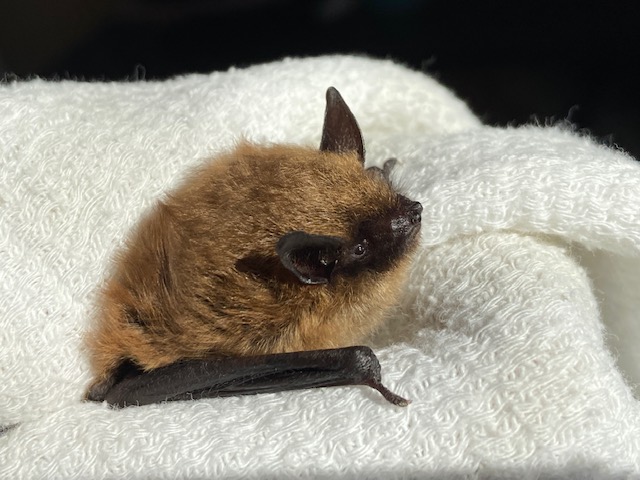
Littlefoot. [Credit: Pennsylvania Bat Rescue]
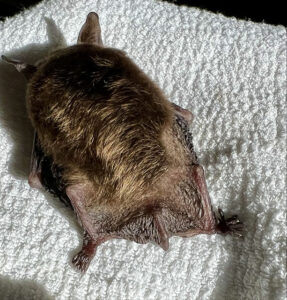
Littlefoot. The Small-Footed Bat is named for its tiny feet. [Credit: Dawn Heinbach]
The Countess is a Hoary bat. Her finder’s neighbor had cut down all of their pine trees in the middle of summer, a time when many young wildlife species are being raised. Some bat species utilize these trees to raise young. Countess was found on patio furniture. Too young to fly, she was starving, injured, and in desperate need of professional care. She was raised by PA Bat Rescue staff, but unfortunately, due to her neurological injuries sustained from the fall, Countess cannot fly. Hoary bats that live in captivity usually live approximately five years.
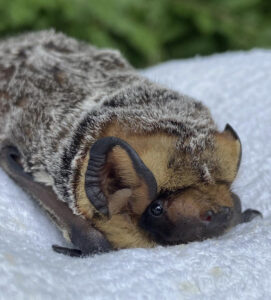
The Countess. [Credit: Pennsylvania Bat Rescue]
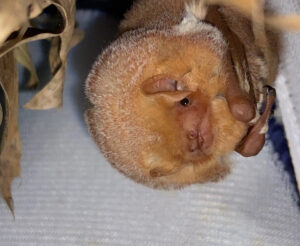
Truffles. [Credit: Pennsylvania Bat Rescue]
Finances and Fundraising
Some bat species hibernate in the winter, and the room temperature where the bats are housed is a constant 50 degrees Fahrenheit. But just because the bats are less active doesn’t mean Stronsick and the volunteers are. In November and December 2022, she admitted 40 bats.
“We’re actually busier in the winter because people are doing home renovations,” Stronsick said. “And first-year bats are not acclimated to the conditions, so [are] being found more easily. They’re roosting inside buildings and on the ground and people find them.”
Stronsick also does more fundraising during the winter months. The rescue has outgrown its current two-car garage in Stronsick’s home and is planning to expand this year. The renovations will include a reception area, storage space, and separate rooms for the educational bats, baby bats, sick bats, and hibernating bats. Medical rooms are also in the future design. “I want a bat hospital,” Stronsick said. The original financial goal for this project was $45,000, half of which the Rescue raised last year. Stronsick hopes to raise an additional $50,000. Their contractor is going to start on some of the renovations this spring.
Since PA Bat Rescue specializes in a certain animal species, it is harder to get grants from the state — and they don’t receive any. All funds come from philanthropic organizations, private donations, and fundraising events.

Stephanie Stronsick, founder and Executive Director, treats a patient.
Credit: Dawn Heinbach
The Realities of Wildlife Rehab
It’s easy to view wildlife rehabilitation through rose-colored glasses, seeing only the excitement and reward of helping wild creatures. Licensed rehabbers are rare — there are only 38 in the state at just 27 locations — making their work especially critical. However, it is anything but glamorous. Over the past 16 years, Stronsick has dealt with the many challenges of operating a bat rehabilitation center. At times, she wonders if she’ll be able to continue.
Her responsibility to the rescue is 24/7, and the resulting toll on her family life is huge. She recalled the one time she was able to take a family vacation, she had to cut it short and return home because she had received several calls about bats. At the time, Stronsick was the only person at the rescue who was vaccinated against rabies, a state requirement for working with bats. About a year after that vacation, Stronsick’s mother, who also volunteers at the rescue, got the rabies vaccine. This allows her to assist when Stronsick may not be readily available. Stronsick is also training new, rabies-vaccinated volunteers who will provide assistance.
Completing her undergraduate degree was especially arduous.
“It was hard to coordinate anything because I had [school work] that’s due, but the bats are not going to come in when it’s convenient. So 10 o’clock at night, I’m running out the door to get a bat when I should be going to bed. Or I’m on the phone — the phone just keeps ringing and I had homework to do. It’s very challenging.”
Still, Stronsick’s passion for the work is evident, despite the hardships.
“I get to observe behaviors that biologists don’t even get to observe,” Stronsick said. “I work with these animals every day, and they have different personalities and different ways of responding to things. I get to be the one who handles them every day … and nothing is more rewarding to me than releasing them.”
There was a time when bats were reviled and feared because of misconceptions about the species, some of which persist today. Stronsick said she enjoys educating the public about bats and showing them bats up close because knowledge dispels those myths. Through her educational programs and rehabilitation work, perhaps more people will come to feel as Stronsick does about the tiny creatures:
“Bats are just an evolutionary little ball of coolness.”
